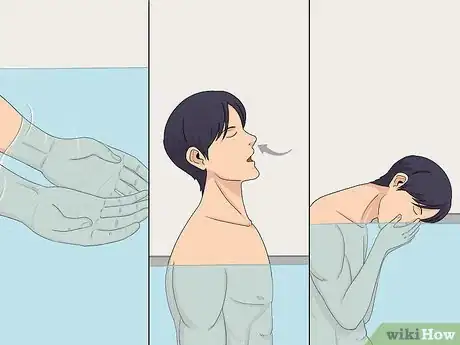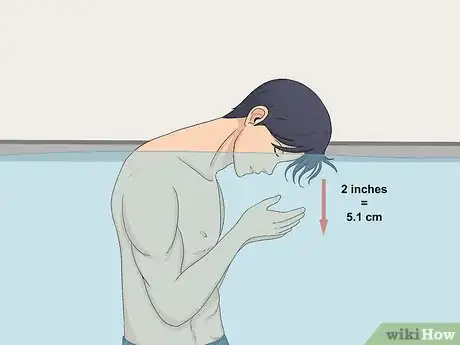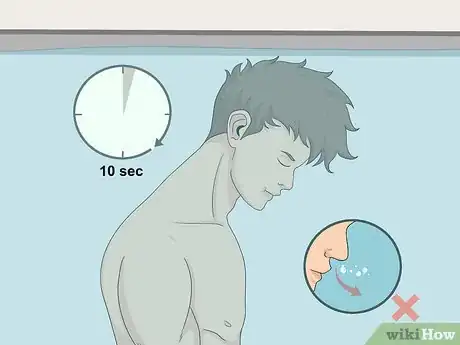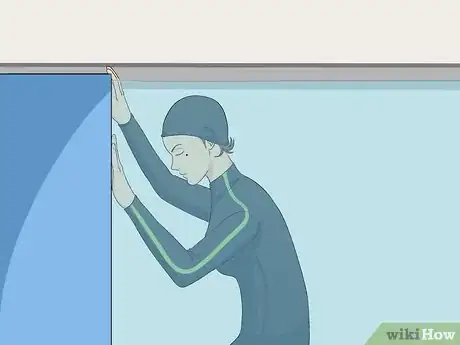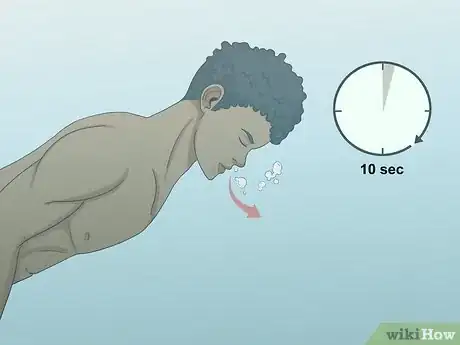This article was co-authored by Hayley Church. Hayley Church is an owner at Cooksey's Lifeguard & Swim Academy, LLC in Southern California. Hayley has been a lifeguard and swim instructor since 2007 and has dedicated her time to teaching people of all ages how to swim. Hayley and her team offer lifeguards and programming such as swim camp counselors, swim lessons, and water aerobics classes to clients of all sizes from large organizations to private homes. She received her Master’s degree in Recreation Management.
There are 7 references cited in this article, which can be found at the bottom of the page.
wikiHow marks an article as reader-approved once it receives enough positive feedback. This article has 11 testimonials from our readers, earning it our reader-approved status.
This article has been viewed 401,320 times.
Learning how to swim underwater without holding your nose is really easy to do. You can build up your confidence by submerging your nose underwater by using a shallow pool, bathtub, or even a sink. To practice swimming around in the water, blow bubbles out of your nose while you’re underwater and learn how to control your breath and keep water from getting in. With practice, you’ll be swimming around underwater in no time!
Steps
Getting Used to the Water
-
1Use a shallow pool or bathtub to practice. To get comfortable going underwater without holding your nose, it helps to practice in a shallow body of water. You can use the shallow end of a pool, a bathtub, or even fill a sink full of water to practice.[1]
- A quiet part of a pool or a shallow pool designed for children can help make you feel more at ease in the water, especially if you're afraid of swimming.
Tip: If you fill a bathtub or sink, use warm water to make it feel even more comfortable.
-
2Cup your hands and exhale into them through your nose. To keep water from getting into your nose, you have to learn how to control the flow of air out of your nostrils. Practice by cupping your hands, placing your nose into your cupped hands, taking a breath, and exhaling through your nose into your hands so you can feel the air.[2]
- Try exhaling for 10-second increments 2-3 times.
Advertisement -
3Put your hands in the water and exhale through your nose. Once you’ve gotten used to controlling the flow of air out of your nose by exhaling into your hands, you can try it out in the water. Lower your cupped hands in the water until they form a bowl filled with water. Then, take a breath, lower your face again into your hands, and exhale through your nose so you can feel the bubbles in your hands.[3]
- Repeat the process until you feel comfortable putting your nose underwater.
- Exhale for about 10 seconds at first, then try to go for about 15 or 20 seconds to push your comfort zone.
-
4Move your hands 2 inches (5.1 cm) deeper into the water and exhale. After you’ve gotten a little more comfortable submerging your nose in the water, lower your cupped hands a little deeper. Then, take another breath, submerge your face into your hands, and breathe out through your nose.[4]
- Notice if you find yourself getting more comfortable in the water. Great job!
- Do this exercise a few times and try exhaling for longer and longer increments.
-
5Put your whole head underwater and exhale through your nose. If you feel confident enough, try putting your head under the water without your hands. Take a big breath and stick your head underwater, then blow out air through your nose.[5]
- Exhale for longer increments each time you submerge your head
-
6Hold your head underwater without exhaling for 10 seconds. Keep a small amount of air held in your nose to keep water from getting in. If you can hold your head underwater without exhaling through your nose, you’re basically swimming! When you feel ready, take a big breath and go underwater. Try to not exhale through your nose and hold your head under the water for 10 seconds.[6]
- Try to push yourself to hold your head under the water for longer and longer periods.
- If you feel really confident, try swimming around a little bit with your head underwater.
Practicing in a Pool
-
1Hold the side of the wall of the pool. When you’re getting the hang of swimming underwater without holding your nose, it can help to hold onto the wall so you feel more secure and comfortable in the water. Find a quiet spot in the pool and grab hold of the edge of the pool.[7]
- Choose a spot in the shallow end of the pool so you can also stand up easily if you need to.
-
2Submerge your head underwater and blow bubbles for 10 seconds. Take a big breath and lower your head into the water. Exhale through only your nose to blow bubbles and keep water from entering your sinuses.[8]
- Try this exercise several times, and try to exhale with less force each time so you can practice controlling your breath.
Tip: If you’re nervous about putting your whole head underwater, try just submerging to about eye level so your nose is underwater. Practice going deeper and deeper as you get more comfortable.
-
3Work to submerge your head without exhaling through your nose. Once you get used to putting your head underwater and you’ve gotten better at controlling your breath by keeping air in your nose, practice holding your head underwater without blowing bubbles out of your nose. Take a big breath, keep a good grip on the wall, go underwater, and hold your breath for 10 seconds while keeping a small amount of air in your nose.[9]
- Do this a few times and try to stay under the water for longer and longer periods of time.
-
4Let go of the wall when you feel comfortable and swim around. Once you’ve gotten better at controlling your breath and keeping water from getting in your nose, try submerging your head and letting go of the wall. Swim around a little bit and come back up for air whenever you need it.[10]
- Practice swimming underwater for longer and longer distances.
Community Q&A
-
QuestionMy friends make fun of me for holding my nose while swimming. How do I practice swimming without holding my nose?
 Felicity M.Community AnswerTry exhaling through your nose in a shallow end of a pool until you are comfortable enough to try it in deeper waters. Also, practice when your friends aren't around until you are confident in your ability to swim without holding your nose.
Felicity M.Community AnswerTry exhaling through your nose in a shallow end of a pool until you are comfortable enough to try it in deeper waters. Also, practice when your friends aren't around until you are confident in your ability to swim without holding your nose. -
QuestionWhen I swim I don't feel comfortable breathing out, and then I inhale water. What should I do?
 Community AnswerPractice in shallow water, with your feet on the bottom of the pool. Once you get used to that, it will be easier to keep water out of your nose while swimming.
Community AnswerPractice in shallow water, with your feet on the bottom of the pool. Once you get used to that, it will be easier to keep water out of your nose while swimming. -
QuestionIf I learn how to not hold my nose underwater, how long can I stay underwater for?
 Community AnswerIt depends on how strong your lungs are. Some people can hold their breath for a while, while others have weaker lungs. Don't try to hold your breath for longer than it's comfortable to do so, and if you feel faint, immediately surface and get out of the water.
Community AnswerIt depends on how strong your lungs are. Some people can hold their breath for a while, while others have weaker lungs. Don't try to hold your breath for longer than it's comfortable to do so, and if you feel faint, immediately surface and get out of the water.
Expert Interview
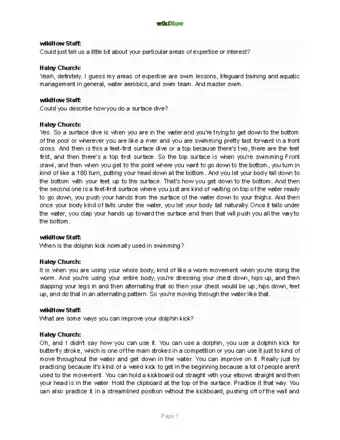
Thanks for reading our article! If you’d like to learn more about swimming underwater, check out our in-depth interview with Hayley Church.
References
- ↑ https://youtu.be/8oCB9SD_V7U?t=62
- ↑ https://youtu.be/zVg_l9PqVOU?t=66
- ↑ https://youtu.be/zVg_l9PqVOU?t=66
- ↑ https://youtu.be/zVg_l9PqVOU?t=66
- ↑ https://goneoutdoors.com/go-underwater-holding-nose-2241821.html
- ↑ https://youtu.be/8oCB9SD_V7U?t=35
- ↑ https://www.mytimetotri.com/training/swim/what-do-i-do-pool
- ↑ https://goneoutdoors.com/go-underwater-holding-nose-2241821.html
- ↑ https://youtu.be/8oCB9SD_V7U?t=65
About This Article
To swim underwater without holding your nose, practice breathing correctly so you don't accidentally inhale water. Start by dunking your head while blowing air out through your nose. Once you’re comfortable dunking, try pushing off the side of the pool and exhaling through your nose as you glide underwater. Then, advance to swimming underwater, coming up for air every 1 to 3 strokes or as needed. To learn how to position your head when swimming without holding your nose, keep reading!


